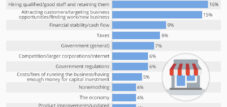The USA's biggest problems today: Economic challenges and solutions
Xpert pre-release
Language selection 📢
Published on: September 22, 2025 / Updated on: September 22, 2025 – Author: Konrad Wolfenstein
5 crises that are paralyzing the US economy: 37 trillion in debt, job losses, inflation, loss of confidence and trade policy
What are the most serious economic problems in the United States right now?
The United States faces a multitude of complex economic challenges that have both short-term and long-term implications for the country. As an observer of the current situation, it is clear that several critical problem areas have emerged that are shaking the foundations of the American economy.
Perhaps the most pressing problem is the US's spiraling national debt. With current debt levels of nearly $37 trillion and a debt-to-GDP ratio of over 120 percent, the country is in a precarious fiscal situation. The trend in the interest burden is particularly worrying: As early as 2025, the US is expected to have to pay $794 billion to its creditors, and in just a few years, interest payments could exceed the $1 trillion mark per year. These debt service expenses already exceed defense spending and tie up significant resources needed for investments in infrastructure, education, and other critical areas.
Another serious problem is the erratic tariff policy under the Trump administration, which has led to considerable economic uncertainty. Tariffs on Chinese goods have been increased to as much as 145 percent, prompting retaliatory tariffs from China of 125 percent. These trade conflicts have not only strained bilateral relations between the US and China, but have also disrupted global supply chains and negatively impacted European companies.
Suitable for:
- Trade conflict with the US due to Trump tariffs: Flexibility as the key to success – Interview with Konrad Wolfenstein of Xpert.Digital
How does current tariff policy affect the American economy?
The effects of tariff policy are already clearly felt, leading to a surprise contraction of the US economy in the first quarter of 2025. Gross domestic product fell by 0.3 percent, after economists had expected growth of 0.3 percent. This decline is largely due to the rush by US companies to increase their inventories ahead of the comprehensive tariffs.
The uncertainty caused by unpredictable tariff policy has led to many investment projects being put on hold. Companies lack a basis for their business decisions, as tariffs are announced, introduced, withdrawn, or postponed on a weekly basis. This planning uncertainty not only slows investment but also leads to weakening domestic demand, as major retail groups have issued profit warnings and announced price increases.
Tariff policy also has an inflationary impact. Most economists expect rising inflation in 2025, as US importers will pass on a large portion of the tariffs to final consumers. This will hit lower-income US households particularly hard, as they spend a larger portion of their income on imported goods.
What developments are showing in the American labor market?
The US labor market is showing worrying signs of weakness, which are seen as clear warning signs of a potential recession. The unemployment rate rose from 4.1 percent in June 2025 to 4.3 percent in August, the highest level since October 2021. Particularly worrying is that only 22,000 new jobs were created in August, less than a third of the expected 75,000 jobs.
The situation for career starters has deteriorated dramatically. According to unanimous media reports, job prospects for school and university graduates have deteriorated dramatically. Many companies are refraining from hiring new employees, and in April 2025, there was exactly one applicant for every newly created position, while the rate was 0.6 two years earlier.
The labor force participation rate has also declined alarmingly, falling to 62.2 percent in July 2025, the lowest level since November 2022. This trend suggests that increasing numbers of people are leaving the labor market entirely due to lack of employment opportunities or discouragement.
How serious is the inflation trend in the USA?
Inflation trends in the US present a mixed picture with worrying trends. While headline inflation was 2.4 percent in September 2024, close to the Federal Reserve's target of 2 percent, the core inflation rate excluding food and energy remains steadfast, rising by 0.1 percent to 3.3 percent. In August 2025, inflation accelerated again to 2.9 percent, the highest level since January.
The price trend for various categories is particularly problematic. Prices for services are still rising noticeably, with housing costs, for example, increasing by 4.9 percent annually. Vehicle prices have also risen: used cars and trucks rose by 6 percent compared to 4.8 percent in the previous month, and new vehicles by 0.7 percent compared to 0.4 percent.
Energy costs, which had long had a deflationary effect, rose for the first time in seven months in August 2025. This could pose an upside risk to overall inflation, especially if oil prices continue to rise due to the escalating war situation in the Middle East.
What role does the Federal Reserve play in addressing these problems?
The Federal Reserve faces a difficult dilemma between fighting inflation and supporting the weakening labor market. In September 2025, the Fed cut its benchmark interest rate by 25 basis points to a range of 4.00 to 4.25 percent for the first time since December 2024. This decision was made against the backdrop of the deteriorating labor market, even though inflation is not yet fully under control.
The Fed is under considerable political pressure from President Trump, who has called on the central bank to make a "big cut." Newly appointed Governor Stephen Miran, previously Trump's chief economist, was the only one to vote for a larger interest rate cut of 50 basis points. This reflects the internal tensions within the Fed regarding the appropriate monetary policy stance.
The central bank faces the paradoxical situation of having to cut interest rates to support the economy, while at the same time fearing a renewed acceleration of inflation due to tariff policy. The Fed's PCE inflation projection for 2026 has been revised upward from 2.4 percent to 2.6 percent, reflecting ongoing inflation concerns.
How serious is the US debt problem?
The US debt problem has reached a level that threatens the country's long-term fiscal sustainability. National debt has doubled since 2015, from $18.2 trillion to the current $36.6 trillion. Without targeted countermeasures such as tax increases or spending cuts, the US could enter a much deeper debt spiral than previously assumed.
KfW simulations depict frightening scenarios: With an annual deficit increase of just 10 percent and an interest rate increase of only 0.1 percentage points per year, a debt ratio of over 170 percent of gross domestic product over a ten-year period is not unlikely. Even under more conservative assumptions, the debt ratio would rise to over 150 percent of GDP.
The interaction between rising interest costs and growing spending is particularly problematic. Higher interest expenditures reduce available fiscal space and, in combination with rising spending, exacerbate the dynamics of the debt ratio. International investors' confidence in the US dollar is already wavering, which is reflected in falling exchange rates and rising interest rates on US bonds.
What structural problems are putting additional strain on the American economy?
In addition to the acute economic challenges, the United States suffers from serious structural problems that threaten the country's long-term competitiveness. The country's infrastructure is in a dilapidated state. The American Society of Civil Engineers gave US infrastructure a sobering "C-" rating in 2021 and estimated the investment gap for the current decade at nearly $2.6 trillion.
Around 60,000 bridges are in urgent need of repair, and 43 percent of the country's roads are in poor or mediocre condition. Infrastructure deterioration not only causes direct costs from necessary repairs, but also indirect losses from congestion and detours. America is already losing approximately one trillion dollars over the next eight years due to congestion, detours, and other traffic disruptions.
The healthcare system represents another structural burden. The US spends an average of $12,500 per person per year on healthcare, while Germany spends less than half that amount. Despite these high expenditures, average life expectancy in the US is lower and infant mortality is higher than in Germany. 25 million Americans have no health insurance at all, while the same number are considered underinsured.
How severe is the education crisis in the United States?
The education crisis in the United States is primarily manifested in exploding student loan debt. Currently, 44 million Americans are paying off their student loans, and five million are already in default. The total outstanding student debt amounts to $1.5 trillion, equivalent to the gross domestic product of Canada.
The average college graduate leaves with $35,051 in debt; for prestigious private universities and doctoral degrees, this amount can climb to over a quarter of a million dollars. The average cost to attend a U.S. college is $38,270 per year, forcing many young people to take on large loans.
The problem is exacerbated by the fact that this debt influences graduates' economic behavior in the long term. Only once the debt is repaid can university graduates freely dispose of their income, buy houses and cars, and possibly start businesses. Economists increasingly view student debt as a hindrance to growth.
What problems does the American real estate market face?
The US real estate market is in a difficult situation, caused by multiple factors. Housing affordability has reached near historic lows. Since 1999, rents have increased by 135 percent, while incomes have risen by only 77 percent over the same period.
A fundamental problem is the lack of available housing. There is currently a shortage of over three million housing units, which is continuously driving up prices. The number of homeless people has risen to 650,000. Young people are particularly affected: around 45 percent of 18- to 29-year-olds still live with their parents or are living with them again – the highest number since the Great Depression in the 1930s.
The Federal Reserve's interest rate policy has exacerbated the housing market's problems. Mortgage interest rates rose from under three percent in 2021 to eight percent at times. At the end of 2021, the rate for a 30-year mortgage was around 2.7 percent, peaking at just under 7.8 percent at the end of October 2023.
The vacancy rate in the American commercial real estate market was over 19 percent in the third quarter of 2023, higher than in the aftermath of the 2008 financial crisis. Many construction projects are becoming unprofitable due to higher interest rates and are therefore not being pursued further.
How is the US government trying to solve these economic problems?
The US government's approaches to solving the country's economic problems are diverse, but often controversial and at times contradictory. In the area of tariff policy, the Trump administration is attempting to strengthen domestic industry and reduce the trade deficit through protectionist measures. Trump consistently promises that his tariff policy will make the country richer and the US economy more successful than ever.
However, the negative effects of this policy are already becoming apparent. Although the US and China have reduced their tariffs from 145 percent to 30 percent, the underlying trade conflicts remain. Substituting imported goods with US-made products is unrealistic, at least in the short term, due to insufficient production capacity and expertise.
The Biden administration has taken significant steps on infrastructure. The Infrastructure Investment and Jobs Act of 2021 provides $1.2 trillion for various infrastructure improvements, including $40 billion specifically for bridge repairs. But given the estimated $2.6 trillion investment gap by 2029, these funds are just a start.
In the education sector, efforts to reduce student debt were made under the Biden administration, but structural reforms to the higher education system largely failed to materialize. High tuition fees and the associated debt problem remain unresolved.
What monetary policy measures is the Federal Reserve taking?
The Federal Reserve pursues a cautious but flexible monetary policy to both combat inflation and support the weakening labor market. The first interest rate cut of 2025, by 25 basis points, in September was a balanced compromise between these competing goals.
The Fed has adjusted its economic forecasts and expects to cut interest rates by another 50 basis points by the end of 2025 and by a quarter point in 2026. At the same time, GDP growth forecasts for 2025 were revised upward from 1.4 to 1.6 percent, indicating a cautiously optimistic assessment of economic developments.
However, the Fed faces a difficult balancing act. The central bank must fend off suspicions that it is easing its monetary policy due to the White House's persistent push for low interest rates, thereby undermining its credibility in the financial markets. The ongoing inflationary threats posed by tariff policy further complicate decision-making.
🔄📈 B2B trading platforms support – strategic planning and support for exports and the global economy with Xpert.Digital 💡
Business-to-business (B2B) trading platforms have become a critical part of global trade dynamics and thus a driving force for exports and global economic development. These platforms offer significant benefits to companies of all sizes, particularly SMEs – small and medium-sized businesses – which are often considered the backbone of the German economy. In a world where digital technologies are becoming increasingly prominent, the ability to adapt and integrate is crucial to success in global competition.
More about it here:
Dilapidated infrastructure and US national debt: Why a turning point threatens in 2034 – interest burden instead of growth – how debt is eating away at America's future
How effective are the measures taken so far to tackle national debt?
The measures taken so far to tackle the national debt are inadequate and, in some cases, counterproductive. President Trump's "Big Beautiful Bill" could increase the US debt by another three trillion dollars by 2034. Neither the Trump nor the previous Biden administration has taken serious steps to reduce the structural deficit.
The US budget deficit is currently between 5 and 6 percent of GDP, which Goldman Sachs economists describe as worrying. The United States' longer-term fiscal outlook is in an "unsustainable position." Even major bond managers like Pimco are showing reluctance to purchase more US Treasury bonds because of growing doubts about the debt sustainability.
A sustainable solution would require significant tax increases or drastic spending cuts, but both options are politically difficult to implement. KfW Research's simulation shows that even with optimistic assumptions about savings efforts, the debt ratio will continue to rise.
Suitable for:
What long-term impact do these problems have on the US economy?
The long-term impact of the current economic problems on the United States is severe and could jeopardize the country's position as a leading economic power. The rampant national debt is leading to a continuous displacement of productive spending by interest payments. Washington already spends more money on interest payments than on defense, and this trend will continue to worsen.
The infrastructure crisis threatens the long-term competitiveness of the United States. If the estimated $2.6 trillion investment gap is not closed, the United States faces economic losses of $10 trillion by 2039. Dilapidated roads, crumbling bridges, and outdated utility systems reduce productivity and increase costs for businesses.
The education crisis is placing a multigenerational burden on the economy. The $1.5 trillion in student debt is tying up the purchasing power of an entire generation and preventing investments in business start-ups, real estate, and consumption. This is dampening long-term economic growth.
The dysfunctional healthcare system places a disproportionate burden on both businesses and private households. High healthcare costs make American companies less competitive internationally and lead to a continuous weakening of the purchasing power of the middle class.
How do experts assess current solutions?
Experts' assessment of current approaches to the solution is largely critical. Regarding tariff policy, the International Monetary Fund warns that the trade war instigated by Trump will not pay off for the United States. US economists criticize that import tariffs help neither US companies nor US workers. If America were to isolate itself, the middle class would lose 29 percent of its purchasing power.
The Federal Reserve has been praised by experts for its cautious approach, but also criticized. LBBW Research sees the Fed in a dilemma between the unexpectedly significant deterioration in the labor market situation and the continued threat of a surge in inflation due to tariff policy. The risk of monetary policy missteps is growing in this conundrum.
Regarding national debt, experts agree that urgent action is needed. KfW Chief Economist Dirk Schumacher sees "little doubt that the US debt mountain will continue to grow rapidly as a consequence of the law." The influential Brookings Institute in Washington has identified "dangerous cracks in the foundations of US democracy," which are also being exacerbated by the economic problems.
Infrastructure investments are generally welcomed but considered insufficient. Although the Infrastructure Investment and Jobs Act represents a significant step forward, the $1.2 trillion allocated is insufficient to close the estimated $2.6 trillion investment gap.
Suitable for:
- Globalization rethought: US experts asked – focus on expansion in the US market – production in the USA?
What alternative approaches are being discussed?
In the economic policy debate, various alternative approaches to solving the structural problems are being discussed. Regarding government debt, economists propose a combination of tax increases and spending cuts. Specifically, higher taxes on corporations and the wealthy, as well as a review of social spending, are being discussed.
In the area of trade policy, many experts advocate a return to multilateral agreements and a less confrontational approach toward China. The European Chamber of Commerce views the trade war critically and warns of its negative impact on global supply chains.
Fundamental structural reforms to the healthcare system are being discussed, including a stronger role for the government in price negotiations with pharmaceutical companies. Some experts are even proposing a single-payer system based on the European model, although this would be politically difficult to implement.
In the education sector, both short-term debt relief programs and long-term cost-control reforms are being discussed. Proposals range from capping tuition fees to increased government funding for higher education.
Regarding infrastructure, an increase in public investment is called for, possibly financed through special infrastructure taxes or a reform of the gas tax, which has not been increased since 1993.
How do these problems affect the international standing of the United States?
The United States' economic problems have already begun to weaken its international standing. International investors' confidence in the US dollar is wavering, resulting in falling exchange rates and rising interest rates on US bonds. This is particularly worrying given that the dollar's status as the world's reserve currency is a key pillar of American economic power.
The trade conflicts have led other countries to diversify their trade relations. China, for example, had already established alternative supply chains during Trump's first term and now imports more soybeans from Brazil instead of the US. A professor at the Chinese European Business School predicts that economic relations between the EU and China will intensify, causing America to lose competitiveness.
The infrastructure crisis is damaging the United States' image as a technologically leading nation. While other countries are investing in modern transportation and communications systems, the United States is struggling with crumbling bridges and outdated systems. This could reduce the country's long-term attractiveness for international investment.
Political instability, partly exacerbated by economic problems, is making the United States a less reliable partner in international relations. The erratic policies of the Trump administration have already shaken the confidence of many allies.
What role does political polarization play in solving problems?
Political polarization in the United States has become a significant obstacle to solving economic problems. The parties struggle to agree on common solutions, even for clearly necessary measures. The Infrastructure Investment and Jobs Act was passed only after tough negotiations and with a significantly reduced budget of $1.2 trillion instead of the original $2.3 trillion.
When it comes to the national debt, the parties are blocking each other: Republicans categorically oppose tax increases, while Democrats oppose major spending cuts. This obstructionist stance is preventing necessary structural reforms and causing the problems to grow further.
Trade policy has become a political football, with short-term political gains often being prioritized over long-term economic rationale. Tariff policy is shaped more by political than economic considerations, leading to the observed unpredictability and resulting problems.
Even in monetary policy, attempts are being made to exert political influence. President Trump has repeatedly put the Fed under public pressure and threatened to dismiss Fed members. This undermines the central bank's independence and makes sound monetary policy more difficult.
What impact do these problems have on American society?
The economic problems are having a profound impact on American society, exacerbating existing inequalities. Inflation is hitting lower-income groups particularly hard, as they must spend a larger share of their income on basic necessities such as housing, food, and energy.
The housing crisis is further exacerbating social inequality. While wealthier segments of the population continue to be able to purchase property, middle and lower-income groups are increasingly being pushed out of the homeownership market. The number of homeless people has grown to 650,000, increasing social tensions.
Educational debt has intergenerational effects. Young people have to postpone life decisions—such as starting a family, buying a home, or starting a business—until they have paid off their student debt. This leads to a delay in important life milestones and influences demographic trends.
The dysfunctional healthcare system increases insecurity among the population. Medical costs are one of the leading causes of personal bankruptcy, meaning that even insured Americans are not safe from financial ruin. This uncertainty influences household consumption behavior and the propensity to save.
Dilapidated infrastructure negatively impacts the quality of life for all Americans. Drivers not only face higher fuel costs but also additional expenses for repairs caused by poor road conditions. In Rhode Island, for example, drivers pay an additional $476 annually for repairs necessitated by poor road conditions.
What are the future prospects for the American economy?
The future outlook for the American economy is mixed, but largely worrying. While the Federal Reserve has slightly revised its GDP growth forecasts for 2025 upward to 1.6 percent, this is well below the historical average. Growth of only 1.8 percent is expected for 2026.
The International Monetary Fund has drastically revised its forecasts for the US economy downwards. While it originally expected higher growth rates, the IMF now expects growth of only 1.8 percent for 2025 and 1.7 percent for 2026. These figures are 0.9 and 0.4 percentage points below the original forecasts, respectively.
The long-term projections for government debt are particularly worrying. Without fundamental reforms, the debt ratio could rise to over 170 percent of GDP by 2034. This would severely limit the government's fiscal capacity and could lead to a crisis of confidence.
Inflation forecasts remain elevated. The Fed expects PCE inflation of 3 percent for 2025 and has revised its forecast for 2026 upward from 2.4 to 2.6 percent. This suggests that tariff policy will continue to have inflationary effects.
The labor market is expected to deteriorate further. The Fed forecasts an unemployment rate of 4.5 percent for 2025, significantly higher than current levels and indicating continued labor market weakness.
What lessons can be learned from the current situation?
The current economic situation in the United States offers important lessons for economic policy. First, it demonstrates that protectionist trade policies can be counterproductive in a globalized world. Erratic tariff policies have caused more harm than good and increased economic uncertainty.
Second, it becomes clear that fiscal responsibility is important even in good times. The United States failed to reduce its national debt during periods of economic strength and is now facing a dangerous debt spiral. This underscores the importance of countercyclical fiscal policy.
Third, the infrastructure crisis demonstrates that investments in public infrastructure cannot be postponed. The decades-long backlog of renovations is now leading to exponentially rising costs and economic losses.
Fourth, the education crisis highlights that high education costs can be counterproductive for economic development. A system that burdens young people with high levels of debt hampers innovation and entrepreneurship.
Fifth, it becomes clear that an efficient healthcare system is not only a social but also an economic necessity. High healthcare costs in the United States burden both businesses and private households and reduce international competitiveness.
Experience also shows that political polarization significantly complicates the solution to economic problems. Only through cross-party cooperation can the structural challenges be addressed.
Finally, it becomes clear that the independence of the central bank is crucial for successful monetary policy. Political interference with the Fed undermines its credibility and complicates the fight against inflation.
Your global marketing and business development partner
☑️ Our business language is English or German
☑️ NEW: Correspondence in your national language!
I would be happy to serve you and my team as a personal advisor.
You can contact me by filling out the contact form or simply call me on +49 89 89 674 804 (Munich) . My email address is: wolfenstein ∂ xpert.digital
I'm looking forward to our joint project.



























